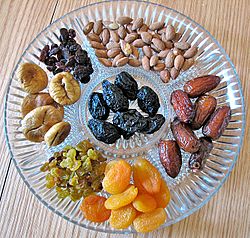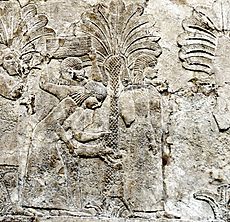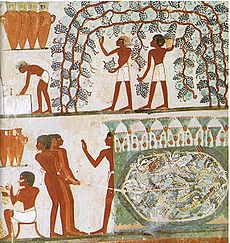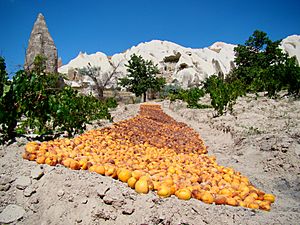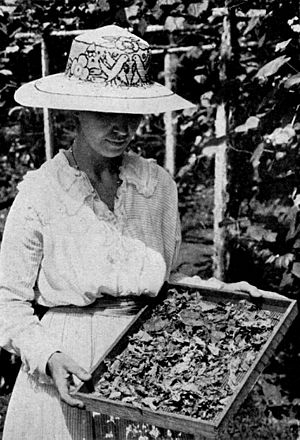Dried fruit facts for kids
Dried fruit is fruit that has had most of its water taken out. This can happen naturally, like when fruit dries in the sun, or by using special machines called dehydrators. People have been drying fruit for thousands of years, all the way back to ancient Mesopotamia. It's popular because it tastes sweet, is full of good nutrients, and lasts a long time without going bad.
Today, lots of people around the world eat dried fruit. About half of all dried fruit sold are raisins. Other popular types include dates, prunes, figs, apricots, peaches, apples, and pears. These are often called "traditional" dried fruits because they are dried in the sun or in heated tunnels. Some fruits, like cranberries, blueberries, cherries, strawberries, and mango, are often soaked in a sweet syrup before they are dried. Also, some products sold as dried fruit, such as papaya, kiwifruit, and pineapple, are actually candied fruit, meaning they are preserved with sugar.
Dried fruits keep most of the healthy stuff found in fresh fruits. The specific nutrients in different dried fruits are similar to their fresh versions, and they depend on how the fruit was dried.
Contents
How Dried Fruit Started
Traditional dried fruits like raisins, figs, dates, apricots, and apples have been a big part of diets in the Mediterranean area for thousands of years. This is partly because these fruits were first grown in the Middle East, in a region called the Fertile Crescent. This area includes parts of modern Iran, Iraq, Turkey, Syria, Lebanon, Palestine, and northern Egypt.
Drying food was one of the first ways people learned to keep food from spoiling. Grapes, dates, and figs that fell from trees or vines would dry out in the hot sun. Early hunter-gatherers noticed that these dried fruits were still good to eat. They liked them because they lasted a long time and were very sweet.
The oldest records of dried fruits are found on clay tablets from Mesopotamia around 1500 BC. These tablets have some of the oldest known recipes! Written in Akkadian, the language of Babylonia, these recipes show that people ate grains, vegetables, and fruits like dates, figs, apples, pomegranates, and grapes. These ancient people used dates, date syrup, and raisins to sweeten their food. They even had over 300 recipes for breads that included dried fruits.
The date palm was one of the first trees people started farming. It was grown in Mesopotamia over 5,000 years ago. Date palms grew very well in the Fertile Crescent and produced a lot of fruit (about 50 kg or 100 lbs per tree each year for 60 years or more!). This made dates a very cheap and common food. Because they were so important, dates were often shown in drawings and carvings on Assyrian and Babylonian buildings. Villagers dried dates and ate them as sweets. Dates, whether fresh or dried, added flavor to meat dishes and grain pies. Travelers also valued them for energy and to fight tiredness.
Figs were also very popular in early Mesopotamia, Palestine, and Egypt. People probably ate them as much as dates every day. Many dried figs have been found in Egyptian tombs, left as offerings. In Greece and Crete, figs grew easily and were a main food for everyone, especially dried figs.
Grape farming began in Armenia and the eastern Mediterranean around 400 BC. Raisins were made by drying grapes in the hot desert sun. Soon, grape growing and raisin making spread across North Africa, including Morocco and Tunisia. The Phoenicians and Egyptians helped make raisins popular, probably because their dry climate was perfect for sun drying. They stored raisins in jars and gave huge amounts to temples. They also added them to breads and pastries, sometimes with honey, milk, and eggs.
From the Middle East, these fruits spread to Greece and then to Italy, becoming a big part of their diets. Ancient Romans ate huge amounts of raisins. They were a key part of their everyday meals, along with olives and fresh fruits. Raisin breads were common for breakfast. Raisins were so valued that they were given as rewards to successful athletes and even used as money to trade for other goods.
Having dried fruits was very important in ancient Rome. Around 100 BC, housekeepers were told to keep a supply of dried pears, figs, raisins, and other preserved fruits. Dried figs were especially popular in Rome. They were added to bread and were a major winter food for people in the countryside. They were sometimes rubbed with spices like cumin, anise, or fennel seeds, wrapped in fig leaves, and stored in jars. Today, major places that produce dried figs include Israel, Jerusalem, Gaza, and many other Arabic countries. Dried figs are full of vitamins and important minerals.
Plums, apricots, and peaches first came from Asia. They were first grown in China around 3000 BC and then spread to the Fertile Crescent, where they were also very popular, both fresh and dried. They arrived in Greece and Italy much later and were very expensive. They were used in fancy dishes, sometimes cooked with honey and spices.
How Dried Fruit is Made Today
| Fruit | Tons |
|---|---|
| Apricots | 1,970 |
| Dates | 16,300 |
| Figs | 14,500 |
| Peaches | 1,365 |
| Pears (Williams or Bartlett) | 400 |
| Prunes | 81,000 |
| Raisins | 350,000 |

Today, dried fruit is made all over the world, and people from all cultures eat it. In the United States, people ate about 2.18 pounds (1 kg) of dried fruit per person in 2006. Raisins made up about two-thirds of this amount. California produces the most dried fruit in the US and the world. It makes over 99% of the US raisins and dried plums, 98% of dried figs, 96% of dried peaches, 92% of apricots, and over 90% of dates. Most of California's dried fruit comes from the San Joaquin Valley, where the soil and climate, especially the hot, dry summers, are perfect for growing these fruits. While many fruits used to be dried in the sun, now only raisins are almost entirely sun-dried naturally.
Fruits can be dried whole (like grapes, berries, apricots, plums), in halves, or as slices (like mango, papaya, kiwi). They can also be chopped after drying (like dates), made into pastes, or turned into concentrated juices. The amount of water left in the fruit can be very small (3–8%) or a bit more (16–18%), depending on the type of fruit. Fruits can also be dried as a puree, like fruit leather, or as a powder. They can even be freeze-dried. This is when fresh fruit is frozen and then put in a special drying room with a vacuum. Heat is added, and the water leaves the fruit while it's still frozen. The fruit becomes very light and crispy and keeps a lot of its original flavor.
Dried fruit is used a lot in making candy, baked goods, and other sweets. Food factories use dried fruits in sauces, soups, puddings, and even baby food.
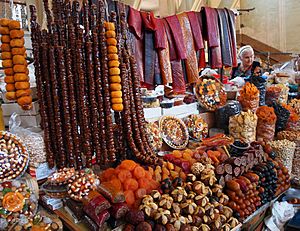
Dried fruit juices, purees, and pastes add special qualities to recipes:
- They have a lot of fiber, which helps absorb water, makes food softer, and adds nutrients.
- Natural acids, like sorbitol, help keep dough and batter stable.
- Fruit sugars add sweetness and help with browning.
- Fruit acids, like malic acid and tartaric acid, make flavors stronger and help stop mold and bacteria from growing.
- Vitamins and minerals make the food healthier.
- Other natural compounds can help keep meats from spoiling and add a natural caramel color.
Because of the high drying temperatures, the fruit's natural low acidity, the low water content, and natural things that fight germs, dried fruits are very stable foods. It's very rare for people to get sick from eating dried fruit.

Sometimes, a substance called sulfur dioxide is used in some dried fruits to keep their color and flavor. For example, it's used in golden raisins, dried peaches, apples, and apricots to stop them from turning dark. Sulfur dioxide has been used in food for a long time.
While sulfur dioxide is usually harmless for most people, it can cause asthma symptoms in some sensitive individuals. The U.S. Food and Drug Administration (FDA) says that about 1 in 100 people are sensitive to sulfites (which sulfur dioxide contains). About 5% of people with asthma might also react to them. Because of this, the FDA requires food makers to say if their products contain sulfites in amounts of 10 parts per million or more. This helps people who are sensitive to avoid those foods.
In 2021, Turkey became the world's largest exporter of dried fruit, selling 1.5 billion dollars worth.
Ways to Dry Fruit
People have been preserving food for a very long time. Drying food helps stop it from spoiling and keeps it good to eat for longer. Reducing the water in fruits stops bacteria, yeast, or fungi from growing. There are several ways to dry fruit, and each method changes how the fruit looks, how well it soaks up water later, and its nutrients. These drying methods include sun drying, tray (air) drying, freeze drying, and vacuum microwave drying. Each method has its own good and bad points.
Sun Drying
This method uses the sun's heat and natural air to dry fruits. It's a very old way to remove water from fruits by spreading them out under the sun. Warm temperatures make the water evaporate, and low humidity helps the moisture move quickly from the fruit into the air. However, sun drying takes a long time, needs a hot climate and daylight, and there's a risk of animals or unwanted germs getting to the fruit.
Tray Drying
A tray dryer is like a special oven with trays stacked inside. Fruits are placed on these trays and put into the oven to dry. These dryers are used in factories where drying is an important part of making products, like dried fruits. Tray drying means drying small pieces of fruit with hot, dry air until they are dry enough to store at room temperature without spoiling much. This method is faster than sun drying and allows for controlled humidity and heat. However, the dried fruit might not soak up water as well later, and it can look shrunken.
Freeze Drying
Freeze-drying is a special way of drying that removes almost all the water and has less effect on the food's taste than other methods. In this process, the fruit is frozen and then placed in a vacuum chamber with low heat. This makes the frozen water turn directly into vapor, skipping the liquid stage. Unlike other drying methods, freeze-drying helps the fruit keep its original shape, color, and it rehydrates (soaks up water) very well. The main downside is that it can be expensive. Foods with enough water are easy to freeze-dry and will keep their shape after the process.
Vacuum Microwave Drying
This method uses microwaves to create heat, which makes the drying time much shorter. Also, under a vacuum, water boils at a lower temperature, which helps dry the fruit from the inside out. Vacuum microwave drying uses microwave energy to heat the fruit while it's in a vacuum. Because there's no air, this method stops the fruit from oxidizing (changing color or taste) and helps keep its color, texture, and taste. This machine can make products better quality and help food last longer, keep its original taste and nutrients, and even make healthy foods more effective. This method offers better flavor, rehydrates well, loses the fewest nutrients, and changes color the least compared to other heat drying methods. It's also faster than freeze-drying.
Gallery
See also
 In Spanish: Fruta seca para niños
In Spanish: Fruta seca para niños


